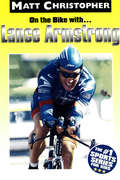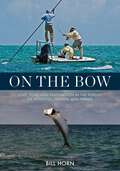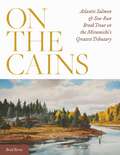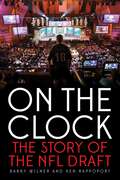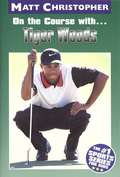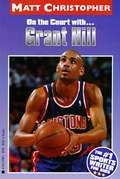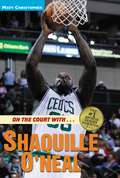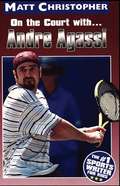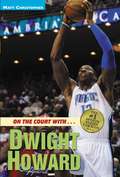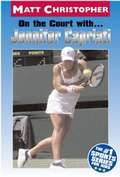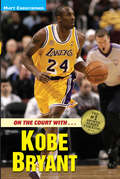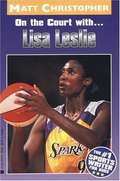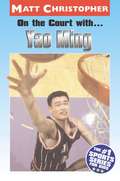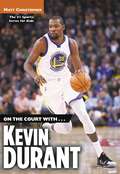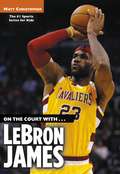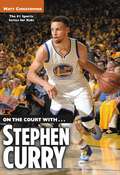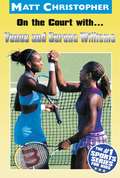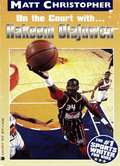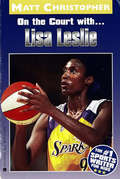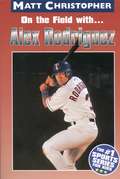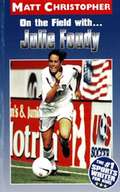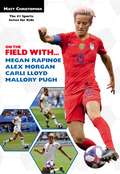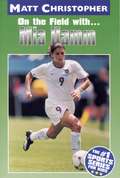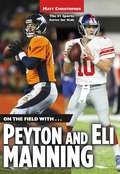- Table View
- List View
On the Bike with...Lance Armstrong
by Matthew F ChristopherA biography of the enthusiastic cyclist whose racing career was interrupted by a battle with cancer before getting back on track with a Tour de France win.
On the Bow: Love, Fear, and Fascination in the Pursuit of Bonefish, Tarpon, and Permit
by Bill HornVeteran saltwater angler and Keys resident Bill Horn shares his years of experience pursuing tarpon, permit, and bonefish and captures the magic and mystery of flats fishing around the world. Not only are biology, behavior, and tactics for the fish covered, but Horn also discusses famous destinations and profiles legendary guides. Guide interviews, fly pattern recommendations, and the latest research round out the instructional information.
On the Cains: Atlantic Salmon and Sea-Run Brook Trout on the Miramichi's Greatest Tributary
by Brad BurnsA historical look at and current guide to the Cains River in New Brunswick. There is almost a mystical aura surrounding the Cains and its Atlantic salmon and brook trout fishery. Only about a third of it was ever settled and then lightly, and by the middle of the twentieth century settlers had all given up and the river reverted to completely wild, which it still is today. The book also explores the Cains&’s relationship with the Miramichi River, in particular the Black Brook, the biggest and most productive pool on the river. In low water, a substantial portion of the Cains&’s fall run of fish stacks up there waiting for rain.
On the Clock: The Story of the NFL Draft
by Ken Rappoport Barry WilnerThe NFL draft features no action on the field. No passing, running, tackling, or kicking. Hey, there isn't even a field. Yet the draft has become more popular than many other sporting events, including the NBA and NHL playoff games, against which it goes head-to-head for viewers. In fact, the draft has spawned its own cottage industry in which names such as Gil Brandt, Mel Kiper Jr., and Mike Mayock have become as well known as any of the first-round selections.In On the Clock, Barry Wilner and Ken Rappoport chronicle the history of the proceedings. The veteran sportswriters take you from the first grab bag in 1936, when Philadelphia chose Heisman Trophy winner Jay Berwanger of the University of Chicago only for him to decline to play in the NFL, to the 2014 draft—considered one of the deepest in talent ever.Along the 78-year journey, learn about the competitions for the top overall spot (Peyton Manning vs. Ryan Leaf), the unhappy No. 1s (John Elway and Tom Cousineau), the big flops (JaMarcus Russell), and the late-rounders-turned-superstars (Tom Brady).Meet the draft wizards, from Paul Brown to Bill Walsh and Jimmy Johnson, and read about the draft whiffs that cost personnel executives their jobs.On the Clock takes you behind the scenes at one of pro football&’s most suspenseful annual events.
On the Course with... Tiger Woods
by Matt ChristopherEven before Tiger Woods stunned the world with his amazing victory at Augusta, he was impressing the golfing community with his perfect swing and pleasing crowds with his mile-wide smile and enthusiasm for the game. In this book, readers learn the details of Tiger's life and career.
On the Court With... Grant Hill
by Matt ChristopherA biography of the son of former Dallas Cowboys halfback Calvin Hill who grew up to become a star basketball player with the Detroit Pistons.
On the Court with ... Shaquille O'Neal
by Matt ChristopherDescribes the life and career of the basketball superstar and center for the Los Angeles Lakers.
On the Court with... Andre Agassi: On the Court with...
by Matthew F ChristopherMatt Christopher, the #1 sports writer for kids, focuses on Andre Agassi, the controversial tennis phenomenon whose image is as hard-hitting as his playing. Real-life sports action plus the author's easy-to-read style equals a sports biography not to be missed.
On the Court with... Dwight Howard
by Matt ChristopherDwight Howard was a high school phenomenon who soared head and shoulders above all other players to become the number one draft pick in 2004. The winning team was the Orlando Magic. Since joining the roster, Howard has powered the team to its first NBA Finals in more than a decade. He's an absolute monster on the boards and in 2009 won the coveted Defensive Player of the Year award. He's also a dunking champion, regularly posting more slams than any other player in the league. And he's not even twenty-five years old! With plenty of seasons still ahead of him, there's no telling how high Dwight Howard will soar.
On the Court with... Jennifer Capriati
by Matt ChristopherJennifer Capriati was a teen tennis phenom at age thirteen. Then, like many other athletes who begin their professional careers in their early teens, Capriati began to feel burdened by the pressures of fame, fortune, and the need to win. Three years after her professional debut, Capriati had learned to hate the game of tennis. She bowed out of the scene to try to live the life of a normal teenager -- but that, too, proved to be difficult, and after some very public mistakes, Capriati decided to turn her life around and try to regain her love of the sport. In 1996, she re-emerged on the tennis scene. She stumbled a few times, but by the turn of the century she had proven that she still had the skills, talent, and determination to be a superstar. This exciting biography traces the life of one of tennis's most controversial stars. For more information on the Matt Christopher Sports Bio Bookshelf, please turn to the last pages of this book.
On the Court with... Kobe Bryant (On the Court with…)
by Matthew F ChristopherKobe Bryant started out as one of the youngest basketball players in the NBA. He is now one of the most talented and well known athletes that basketball has ever seen. This sports biography covers Bryant's childhood and the events that brought him to become the basketball player he is today.
On the Court with... Lisa Leslie
by Matt ChristopherSince signing with the Los Angeles Sparks in 1997, Lisa Leslie has impressed WNBA fans with her shooting, rebounding, and blocking abilities. But her notable achievements go further back. In the 1996 Olympic Games, she scored 29 points in the gold medal victory over Brazil. Her Pac-10 record for scoring, rebounding, and blocking still holds, as does her University of Southern California record for blocks. Part-time fashion model, Lisa Leslie is a high-profile athlete young readers will enjoy learning more about.
On the Court with... Yao Ming
by Matt Christopher Glenn StoutYao Ming is one of the biggest stars in basketball today-literally. At seven feet, six-inches, Yao's impressive performance for the NBA's Houston Rockets earned him the Rookie of the Year Award in 2002-2003, and put him on the covers of Sports Illustrated and other magazines, as well as in television commercials for brands such as Visa and Gatorade. His gentle nature off the court doesn't impede his domination on the court, and his sensational seasons have brought a new surge of interest to the NBA.
On the Court with...Kevin Durant
by Matt ChristopherDiscover the amazing achievements of beloved basketball superstar Kevin Durant in this exciting and comprehensive new biography! From his days as the skinny kid on youth teams to his MVP season with the Oklahoma City Thunder to his first NBA Championship with the Golden State Warriors, Kevin Durant has been an electrifying presence on the basketball court. With two Olympic gold medals, four NBA scoring titles, and an NBA MVP Award, Kevin shows no sign of slowing down. Through every triumph, Kevin has lived his life by the motto "hard work beats talent when talent fails to work hard," dedicating himself to becoming the best player on the court and known for remaining humble and kind through it all. This action-packed and comprehensive biography brings readers onto the court to experience the biggest moments of Kevin Durant's remarkable career, relays details of his life, and shows his dedication to giving back to his community. Complete with stats and photographs, this book makes the perfect gift for any young sports fan.
On the Court with...LeBron James
by Matt Christopher Stephanie PetersGet on the court with basketball superstar LeBron James in this in-depth, updated biography!LeBron James was a sensation in his early days playing ball in Akron, Ohio, and he continued to amaze as a high school phenomenon. Now an international icon and the heart of his hometown Cleveland Cavaliers, he is widely known as one of the greatest basketball players ever to step onto the court. Discover LeBron James's incredible story in this in-depth biography of one of basketball's brightest stars. The book takes readers on the court through suspenseful accounts of pivotal games, paints a picture of LeBron's on- and off-court triumphs and challenges, and includes bonus stats, career highlights, and photographs.
On the Court with...Stephen Curry (Matt Christopher Sports Bio Bookshelf)
by Matt ChristopherDiscover the amazing achievements of fan favorite two-time MVP Stephen Curry in this brand-new, comprehensive biography.Steph Curry is a two-time NBA Most Valuable Player, record-breaker, and Finals champion who electrifies fans with his incredible on-court feats. He's also a dedicated husband, father, and philanthropist who inspires people on and off the court. Learn more about this remarkable athlete in this biography, complete with stats and photographs.
On the Court with...Venus and Serena Williams
by Matthew F ChristopherThis sports biography details the dual careers of the famous tennis playing sisters Venus and Serena Williams. in 2002, Serena won the Wimbledon singles title by defeating her sister. As partners, Venus and Serena won the 2002 doubles championship. This biography details the ways in which the sisters have succeeded as competitive athletes, but have also remained true to each other.
On the Court with…Hakeem Olajuwon
by Matthew F ChristopherThe star running back of the NFL. The All-Star center leading his team to the championship. Matt Christopher delves into the life of both of these sports stars, exploring the paths they have traveled, the hardships they have overcome, and the highs and lows of their careers. Each book contains exciting black-and-white action photos, the player's stats, and a list of his career highlights. Real-life sports action plus Matt Christopher's easy-to-read style equals a series not be missed.
On the Court with…Lisa Leslie: On the Court With...
by Matthew F ChristopherSince signing with the Los Angeles Sparks in 1997, Lisa Leslie has impressed WNBA fans with her shooting, rebounding, and blocking abilities. But her notable achievements go further back. In the 1996 Olympic Games, she scored 29 points in the gold medal victory over Brazil. Her Pac-10 record for scoring, rebounding, and blocking still holds, as does her University of Southern California record for blocks. Part-time fashion model, Lisa Leslie is a high-profile athlete young readers will enjoy learning more about.
On the Edge: Four True Stories of Extreme Outdoor Sports Adventures
by Martin DugardAccounts of athletes of extraordinary grit feature a rock climber stranded without food, a woman kayaking in Siberia, a blind trans-Atlantic solo sailor, and the American team in the world's most grueling endurance event.
On the Field with... Alex Rodriguez
by Matthew F ChristopherAlex Rodriguez is the one of the most electrifying baseball players to hit the diamond in recent years. Drafted right out of high school, he has suffered none of the adjustment problems that typically plague young players. On the contrary, he has shown the world what it means to be a superstar, not just on the field but in life. His outstanding play with the Seattle Mariners helped send that team to post-season playoff games year after year. Yet never has A-Rod let success and fame go to his head. Alex Rodriguez's commitment to the game and sportsmanship has made him respected and admired by fellow players and fans the world over. This new biography traces Alex's career from the Seattle Mariners to his latest position with the Texas Rangers.
On the Field with... Julie Foudy
by Matthew F ChristopherThe number one sports writer for kids presents a biography of Julie Foudy, who was a co-captain of the Gold Medal-winning U. S. women's Olympic soccer team in 1996 and played on the U. S. National Team that won the Women's World Cup in 1999. Photos.
On the Field with...Megan Rapinoe, Alex Morgan, Carli Lloyd, and Mallory Pugh
by Matt ChristopherThis action-packed and inspiring collection of brand new biographies takes readers onto the field with their favorite soccer stars.The U.S. women's national soccer team cemented their legendary status with their 2019 World Cup championship. Get to know four of the team's most talented players and prominent stars: the steadfast Carli Lloyd, superstar Alex Morgan, newcomer Mallory Pugh, and fearless Megan Rapinoe. This action-packed biography collection brings readers onto the field with the women's national team to experience the biggest moments of their careers, and the journeys that brought these players together. Complete with stats and photographs, this book makes the perfect gift for any young sports fan.
On the Field with...Mia Hamm: On the Field with...
by Matthew F ChristopherWomen's soccer has never been more popular. At the top of the sport's list of star players is Mia Hamm. Her speed, aggressive play, and ability to "read the field" have sparked every team she's ever played on. At the University of North Carolina, she helped the Tar Heels capture four NCAA championships. Her continually stellar performances with the United States national team led them to win two out of three Women's World Cups, first in 1991 and again in 1999. And as a member of the 1996 gold medal-winning Olympic team, she played an outstanding final game on a sprained ankle. The holder of the world record for most goals scored in a career, she is the hero of thousands of soccer fans worldwide. Readers will devour every detail of this insightful biography of the best women's soccer player in the world.
On the Field with...Peyton and Eli Manning (Matt Christopher)
by Matt Christopher Stephanie PetersNo other family has conquered football like the Manning's. It all started with the dad, Archie, a former pro quarterback who taught his sons Peyton and Eli to play football. Now, as the brothers have both grown into pro quarterbacks', they're creating a legacy of their own, starting with two stunning Super Bowl wins. This exciting Matt Christopher biography gives readers the story behind this famous football family, as well as thrilling recaps of some of the most awesome games in NFL history.
